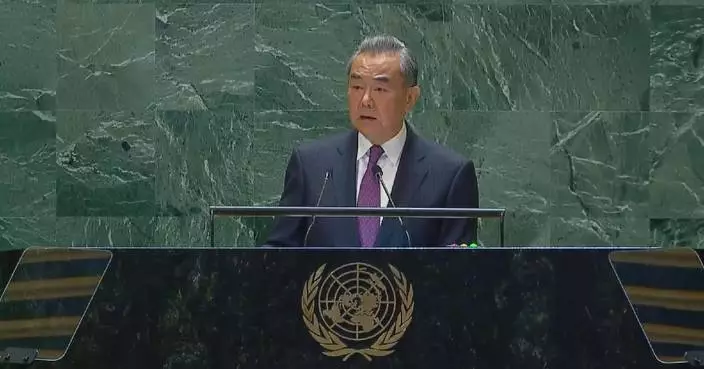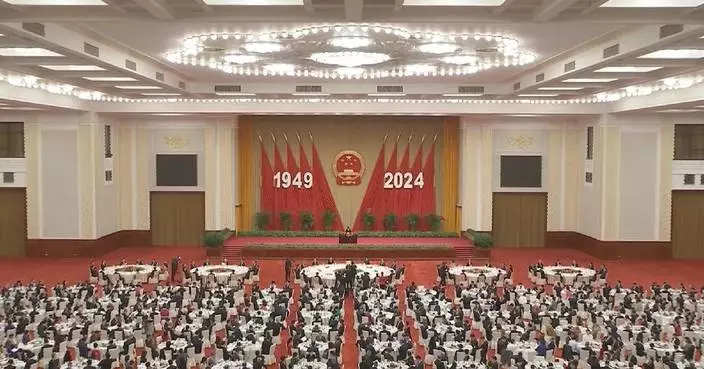As China has made remarkable achievements in space exploration, the country is determined to venture into the deep space.
A piece of special report by China Global Television Network (CGTN) outlined the growth of China's aerospace industry over the past 75 years. The third part of the report encapsulates China's monumental strides in deep space exploration and the technological advancements driving these endeavors forward.
China's deep space exploration is focused on Mars, one of Earth's closest neighboring planet that is 225 million kilometers away. While a space probe can reach the Moon in just 12 days, the vast distance takes a space probe nine months from Earth to Mars.
The development of the Long March-5 rocket series has been crucial to China's deep space exploration ambitions, as it bridges the gap to Mars.
In aerospace circles, there's a saying: "The launch capacity of rockets is as large as an aerospace program." But the road to building a more powerful rocket is laden with challenge and pressure.
The debut launch in 2016 of the Long March-5 rocket was successful. But the year after, the rocket failed 346 seconds after it took off.
"It was too painful, unbearable to look back on. We saw the moment when the curve went wrong. It's the hard work of 30 years. It was very stressful to see the rocket failure. We described that period as like groping in the dark, not knowing when we'd see the light," said Li Dong, chief designer of the Long March-5 rocket series.
Engineers and researchers spent over 900 days and nights proposing new designs, doing tests, improving material and resolving technical issues. In 2019, the third rocket of this series, the Long March-5 Y3, was rolled out to the launch tower.
With 90 percent of the technology of the Long March-5 series newly invented, the Long March-5 is capable of carrying a payload of 25 tons into low Earth orbit, 14 tons to geostationary transfer orbit, and eight tons to Earth-Moon transfer orbit, over twice the capacity of the main Long March series rockets. Its capacity equals other mainstream large-scale rockets in the world.
In 2020, the Long March-5 Y4 rocket was assigned to its first Mars mission--to launch the Tianwen-1 probe, which means "Questions to Heaven" in Chinese, on its voyage to the Red Planet.
China's first attempt to reach Mars is ambitious. It aims to complete orbiting, landing and roving in one mission.
"It should be the greatest in terms of technical performance and technical difficulty. It shows China's ability in the aerospace industry. This is not only a symbol of our great strength, but also a contribution to the scientific progress of the world," said Long Lehao, a senior consultant of China's Mars mission.
In May 2021, after 10 months of travel from Earth, the lander successfully touched down on Mars.
A week later, the Mars rover Zhurong, which was named after an ancient Chinese god of fire, drove off the the landing platform of the Tianwen and onto the Martian surface. The Zhurong rover's successful deployment made China the second nation to accomplish this feat.
So far, the Zhurong rover has completed explorations of the Martian surface, passing through complex terrain, detecting Martian rocks, sand dunes and impact craters, obtaining a large amount of data using its onboard scientific equipment.
These new results reveal the impact of wind and water activities on the geological evolution and environmental changes on Mars. It strongly supports the hypothesis that there was once an ocean on Mars' northern lava plain known as Utopia Planitia.
"When we go to Mars, we can gain a lot of new knowledge and new discoveries. Through this project, we have introduced many new technologies. These new technologies, in turn, can be applied into people's daily lives," said Zhang Rongqiao, a chief designer of China's first Mars exploration mission.
"The aerospace industry has high requirements for material performance, which in turn lead and drive the application of materials in other fields. For example, in high-end medical testing, BGO crystals can be used in PET-CT for early detection of malignant tumors," said Wang Dong, secretary of the Communist Party of China (CPC) Committee of Shanghai Institute of Ceramics, under the Chinese Academy of Science.
Over six decades, China has built its aerospace industry from scratch into a force for peaceful development that rivals global space standards, thanks to generations of visionary, intrepid scientists and engineers, committed to the country's aerospace development.
"I hope that comrades will carry forward the spirit of two bombs and one satellite and the spirit of manned spaceflight, face the forefront of world aerospace development and the country's major aerospace strategic needs, strengthen mission responsibilities, and have the courage to innovate and make breakthroughs," said Chinese President Xi Jinping.
With a legacy built on courage, determination, and a thirst for exploration, China's aerospace journey continues, driven by the spirit of those who dare to reach for the stars.
"What foreigners can do, why can't the Chinese do?" said Qian Xuesen, a forerunner of China's space program.
"There are definitely risks involved in scientific exploration. There are always people who seek high-risk professions. Since they have chosen this career, they should shoulder this responsibility," said Yang Liwei, China's first taikonaut in space.
"Just as with early ocean exploration, we don't know where the other shore is. We will risk our lives looking for it. The exploration will never stop, this time, next time, or many other times in the future," said Chu Yingzhi, deputy project manager of Tianwen-1's orbiter.

Chinese scientists vow to continue aerospace journey despite challenges
The growth of China's aerospace industry not only enables Chinese scientists to conduct experiments in space, but also embraces international cooperation, according to a piece of special report by China Global Television Network (CGTN).
The CGTN special report has outlined the growth of China's aerospace industry over the past 75 years. The second part of the it delves into experiments conducted on China's space station and its commitment to international collaboration.
At the testing center of China Academy of Sciences' Shanghai Institute of Ceramics, a team has conducted a melt thermophysical performance test in the Container-free Laboratory Cabinet at China's space station. The test aimed to eliminate the gravitational influences that distort measurements on Earth, ensuring greater accuracy in thermal properties assessments.
"The reason why we need to do it in space is because it is not accurate on the ground. Experiments on the ground are influenced by gravity. It will greatly impact the measurement of thermal properties. For example, viscosity is one of the important indicators of the performance of high-temperature thermal materials. The effect of gravity will cause buoyancy convection. This will lead to the uncertainty of viscosity measurements exceeding 30 percent. If the figure exceeds 30 percent, it is not considered reliable. But if you do it in space, the accuracy will be much higher," said Zeng Yi, director of the testing center.
The projects are housed in specially built units that can withstand extreme conditions.
"It took us eight years to make the high-temperature material test cabinet and the containerless materials rack. For the high-temperature materials rack, one of the biggest difficulties was getting it to withstand extremely high temperatures of up to the maximum 1,600 degrees Celsius. The second challenge is to develop multi-sample management. The third was that we have achieved real-time X-ray observation under the microgravity of a space station for the first time. Leakage of X-ray can't happen. But the main difficulty is the X-ray protection device has to be limited by the volume and weight. We did five rounds to reduce the device's weight. It provides a very good method for material research. The technique enables us to observe the material preparation process in-situ under microgravity in space. It's also the first time that people are able to implement such a measure in a space station," said Liu Xuechao, the chief designer of the high-temperature material rack of Shanghai Institute of Ceramics.
The experiments aboard China's space station also include the projects jointly selected by the United Nations Office for Outer Space Affairs and the China Manned Space Agency.
While the Tiangong space station orbits the Earth at an altitude between 340 to 450 kilometers, further off at an altitude of 500 kilometers within the sun-synchronous orbit is China's first dark matter detection satellite "Wukong" or Monkey King, which helps pin down the identity of dark matter.
Launched in 2015, the Dark Matter Particle Explorer satellite aims to detect the highest-energy beams of light, known as cosmic rays. The eyes that help "Wukong" identify particles are the 308 BGO crystals, which at 60-centimeters long, were the world's longest BGO crystals back then.
"The longer the length of such a crystal, the larger the detection area that can be formed. This will allow us to cover a larger angle of dark matter or possible sources of signals. The invention process began in 2010 and lasted almost four and a half years. It was quite a hard journey. The difficulty is that our growth device has many physical limitations. Conventional preparation processes are no longer compatible with the control of such a growth process. Another difficulty is the control of the crystal's growth. We didn't have much understanding and control methods at that time. The main breakthrough is the development of a growth device with four-temperature zones. It is also equipped with our growth process. We also built better platforms for performance characterization," said Chen Junfeng, deputy director of the research group of Advanced Radiation Detection Crystals and Devices at the New Materials Research and Development Center of Shanghai Institute of Ceramics.
China's dream of space exploration extends far beyond Wukong's orbit, reaching approximately 380,000 kilometers away to encompass Earth's satellite, the Moon, and the vast expanse of deep space.
In 2004, a year after Yang Liwei's successful space voyage on Shenzhou-5, China launched its lunar exploration program.
"We must advance towards the solar system. China must work harder to do better to have more innovation and new discoveries," said Ouyang Ziyuan, then chief scientist of China's Lunar Exploration Program.
Three years later in October 2007, China launched its first lunar probe Chang'e-1, named after the mythical Chinese goddess of the moon.
From obtaining lunar images to a soft-landing on the Moon, from performing scientific surveys to bringing back lunar samples for research, China's lunar exploration program has achieved milestones towards its goal of finally landing taikonauts on the Moon by 2030.
In the latest lunar mission, Chang'e-6, which was launched in May 2024, has achieved a first in human space history, the successful retrieval of samples from the moon's far side.
"We are open and welcome international cooperation from all countries, including those countries from the Global South, emerging BRICS countries, as well as Western and EU countries. We do not have any isolation or exclusion policy, and we want to cooperate in an all-round way," said Wu weiren, chief designer of China's Lunar Exploration Program.

Growth of China's aerospace industry enables space experiments, embraces global collaboration










